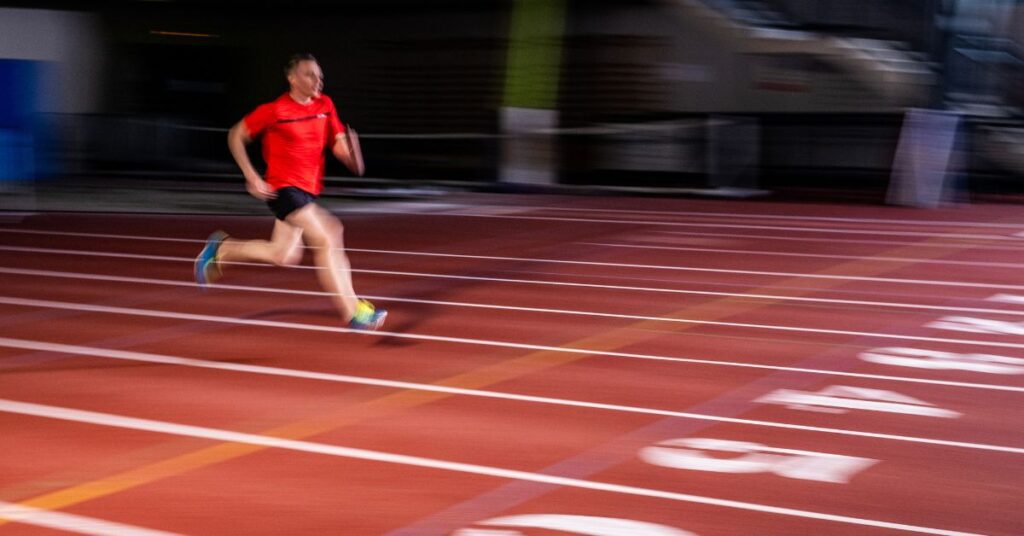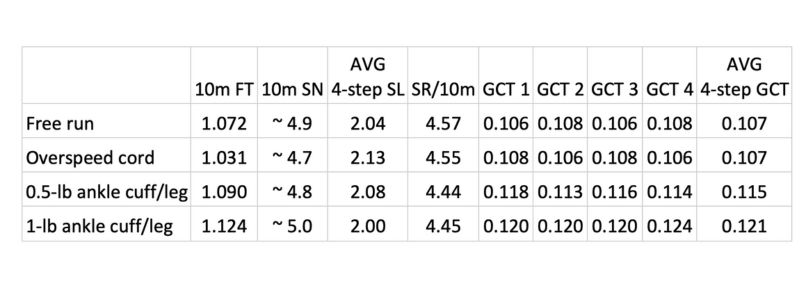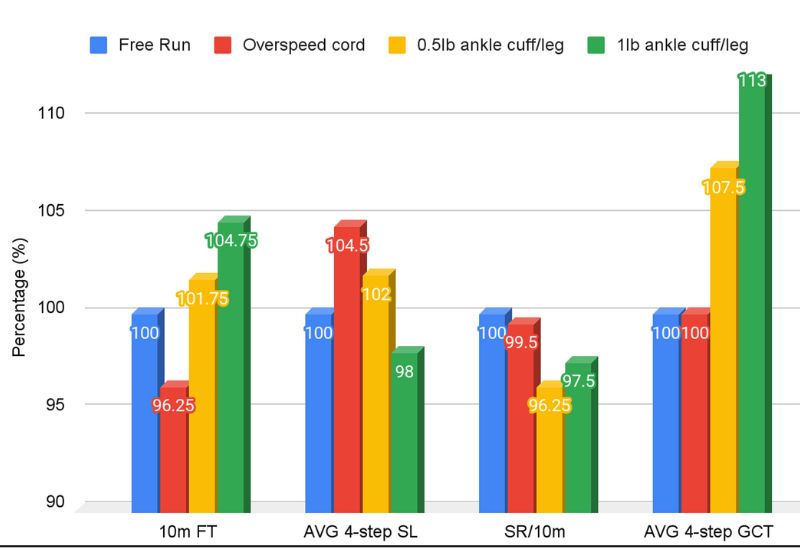
According to the research, maximal running speed can only be maintained for approximately one second, even by the world’s most naturally gifted and best-trained athletes. Depending on the athlete’s level, they can cover anywhere between 10 and 12 meters (approximately) in one second. After that, any further efforts can only briefly maintain the top speed and then attempt to minimize the inevitable deceleration. After about one second of maximal speed, the only question is what the deceleration rate will be.
For that reason, evaluating maximal running speed for more than one second will also include the sprint endurance component. Therefore, the 10-meter (m) fly runs are the only simple and cost-effective way to evaluate maximal running speed. To clarify, flying 20s, 30s, and longer distances also include the sprint endurance evaluation, and absolute speed is no longer achievable.
10m fly runs are the only simple and cost-effective way to measure maximal running speed. Share on XBased on the maximal speed an athlete can produce, a potential for maintaining and enduring it can be closely estimated. That leads to a conclusion about the direct relationship between maximal running speed and the potential of enduring it; in other words, the higher the maximal speed, the greater the starting point for the speed to be endured. That puts the importance of maximal speed into perspective.
A Speed Experiment
The study I undertook aimed to evaluate the maximal sprint speed in one male college-aged club athlete. The track was marked with cones and athletic tape across the lane at the start of the acceleration. We used the same marking procedure at the beginning and end of the 10m fly zone. In addition, the fly zone was marked at four additional positions, spaced 25 centimeters apart before and after the 10-meter markers, to ensure the step count and timing precision in case the athlete made his first step before or after the designated 10-meter zone.
This track marking method created a 1-meter zone before and after the beginning and end of the 10m fly zone. That made it a 2-meter total distance at the beginning and 2 meters at the end of the 10m fly zone, plenty to ensure the athlete wouldn’t be able to make the initial step outside of the zone.
The athlete wore sprint spikes and was recorded with a smartphone from about 6m–10m, running perpendicularly to the video-recording camera. The phone was held horizontally, about 1.4–1.5 meters above and parallel to the ground. The camera was set to “slow-mo” mode or 240 frames per second (FPS) video quality. After the videos were recorded, they were transferred to a “Coach My Video” application (CMV), where the 10m flying times and relevant running-quality parameters were calculated within a 0.004/s (four one-thousandths of a second per frame) precision. Each video was analyzed in the CMV app, one at a time.
The maximal sprint speed was measured for 10 meters after a 30-meter approach under four different conditions in the order listed below:
- Free run.
- Acceleration assistance with an elastic “overspeed” cord + release approximately 10 meters before the 10-meter fly zone beginning.
- With half-pound ankle cuffs around each ankle.
- With 1-pound ankle cuffs around each ankle.
The athlete was instructed to produce maximal effort during the 30-meter acceleration phase and throughout the 10m fly zone. The first run was performed after the athlete was warmed up and fully rested. Each of the three subsequent runs was performed after six minutes of rest, which is considered a full recovery, meaning that each subsequent run began without the presence of fatigue.
Why Are These Results Relevant?
The purpose of this pilot experiment was to measure maximal speed times and their contributing factors precisely to familiarize the reader with the degree of change between each of the four different types of sprints performed.
The most important factors are:
- Ground contact time (GCT).
- Step frequency (rate).
- Distance per step.
Understanding maximal speed and its determinants allows coaches and athletes to reduce or even eliminate the guesswork from training.
Understanding maximal speed and its determinants allows coaches and athletes to reduce or even eliminate the guesswork from training. Share on XCompared to the free run, results from the overspeed cord-assisted and half-pound and 1-pound ankle cuff/leg runs provide information on when assistance and resistance types of runs can be applied during preparation. In contrast, free runs can be used almost throughout the year.
Video 1. Free Run.

Figure 1. Abbreviations key: a) (FT) fly time from 30m approach; b) (SN) step number; c) (SL) step length; d) (SR) step rate/10m; e) (GCT 1–4) ground contact time per step; and f) (AVG) average.
*All distances are in meters (m).
**All times are in seconds (s).
***Air times are considered irrelevant and were not calculated.

Figure 2. Differences in 10m sprint assistance and resistance times and distances are calculated from Free Run and expressed as a percentage (%).
*Values are calculated from figure 1 and rounded to the closest .25.
**For FT and GCT, a lower % indicates better values.
***For SL and SR, a higher % indicates better values.
****The abbreviation key is identical to figure 1.
Overspeed Cord-Assisted Run
As expected, the overspeed cord showed a faster 10m time than the free run. The running time/speed improved by 3.75%, and the average four-step length increased by 4.5%. This data shows that the overspeed cord-assisted acceleration is a powerful tool for training those functions.
Video 2. Assisted sprint using overspeed cord.
Simultaneously, the step rate decreased minimally by .5%, while the four-step average GCT did not change. This data indicates that different training methods should be used to train only the GCT and step rate/frequency, the essential contributing factors in maximal speed training.
The overspeed cord training method is typically recommended for advanced athletes during the late-season or competitive training cycle several weeks before the main competition. Also, if an athlete hits the speed plateau or “speed barrier” in training, this method is a well-known strategy to help athletes overcome it.
Caution should be used, as overspeed training arguably poses a greater injury risk than the free run since the running speed becomes artificially enhanced beyond the athlete’s natural ability. Additionally, supramaximal speed sprints dictate that athletes should be monitored even more closely, as they pose a greater risk for the sympathetic overtraining type. Elastic cords should be fully covered with fabric to prevent possible injuries caused by unexpected tearing and snapping back at the athlete or the partner while towing the athlete.
Resistance Runs with Ankle Cuffs
As expected, in comparison to the free run, both resistance runs, with half-pound and 1-pound ankle cuffs per leg, produced slower running times and lower speed-determining factor values.
Resistance runs with a half-pound ankle cuff/leg caused a speed loss of 1.75% from the free run, a 2% longer average step length, a 3.75% reduction in step rate (frequency), and a 7.5% longer four-step average GCT.
Video 3. Sprint with ankle cuffs providing weighted resistance.
Compared to the free run, the 10m fly run with a half-pound ankle cuff/leg showed a steep loss of running speed. When adding another half-pound per leg, an additional loss of speed by 3% followed, making it a total 4.75% difference between the free run and run with a 1-pound ankle cuff/leg. Compared to the free run, while wearing 1-pound ankle cuffs/leg, the average step length dropped by 2%, the AVG step rate dropped by 2.5%, and the AVG four-step GCT plummeted by a staggering 13%.
As the data shows, runs with ankle cuffs do not immediately improve any of the maximal speed components. They should be used primarily during training cycles focused on strength building. Running-specific resistance training is compatible with most types of strength training and can be effectively implemented into the training program during the training cycles emphasizing strength gain.
As the data shows, runs with ankle cuffs do not immediately improve any of the maximal speed components. They should be used primarily during training cycles focused on strength building. Share on XIf weightlifting training is planned for the same day as anaerobic-alactic resistance runs, it should be done as the second part of the practice, not vice versa.
To minimize the risk of injuries, the training effect of preceding general conditioning (GPP) should become relatively stable before advancing to more sprint-specific efforts such as resisted runs. Coaches should carefully plan gradual additional increments of the ankle cuff weight, resisted sprint distance, and volume. They should never use resistance runs in the weeks leading up to competition, as this will slow down the nervous system (CNS) and reduce the athlete’s performance.
By understanding the data from figure 1 and the differences presented in figure 2, coaches can decide on the type of running stimulus most suitable for their athletes’ needs in training.
To accurately select, dose, and effectively fit each type of training stressor into the general training plan, coaches should frequently record their athletes using the video recording method described at the beginning of the article, document data, and analyze how far the athlete’s sprint parameters are from the desired values at any time during preparation.
It is important to mention that too many coaches and athletes rely on auto-timing systems, often with questionable precision. While such timing systems can be practical for large groups or beginner athletes, other than measuring the flying times, they were not designed to measure GCT, step length, rate, or relevant body angles—the essential components of the athlete’s step pattern to be analyzed and trained based on those values. Because of that, when using auto-timing systems in training, it is impossible to pinpoint the exact factor that needs improvement: GCT, step frequency, step length, or the athlete’s mechanics.
Training Ideas
Other sprint-specific resistance and assistance training methods that provide relatively similar types of stress to sprints performed with ankle cuffs and an overspeed cord, respectively, are listed below:
Resistance training:
- Up the hill/stair runs.
- Sled or partner pulls and pushes.
- Weighted vest or weighted shorts.
- In the water (with or without water resistance equipment).
- Against the wind.
- On sand.
Assistance training:
- Downhill to flat.
- Self-propelled, curved treadmill.
- Stick drills (wickets) with sticks spaced closer than the natural stride length (10%, 15%, 20% closer, etc.).
- With the wind.
- Running in the air (hanging off the pull-up bar or gymnastics rings or from the parallel bars).
- Antigravity treadmill.
Running speed-specific training methods that isolate its components from figure 1 and detail how to effectively implement maximal speed, resisted speed, and assisted speed training into a general training plan are beyond the scope of this article. Please consult the references listed or other adequate literature for that purpose.
Since you’re here…
…we have a small favor to ask. More people are reading SimpliFaster than ever, and each week we bring you compelling content from coaches, sport scientists, and physiotherapists who are devoted to building better athletes. Please take a moment to share the articles on social media, engage the authors with questions and comments below, and link to articles when appropriate if you have a blog or participate on forums of related topics. — SF
References
Korchemny R and Hoskisson JL (1994). Innovations in speed development, an advanced model. Dr. Remi Korchemny, 6435 Ridgewood Drive, Castro Valley, California 94552.
Mann R and Murphy A (2022). The Mechanics of Sprinting and Hurdling. Independently published.
Walker J, Tucker C, Paradisis G, Bezodis I, and Bissas A. (2019, February). Biomechanical Report for the IAAF World Indoor Championships 2018, 60m Men & 60m Women. Birmingham, UK: International Association of Athletics Federations. www.Worldathletics.com. Retrieved April 1, 2024, from World Athletics.


This is amazing research and findings. It is very helpful to the amateur runner.